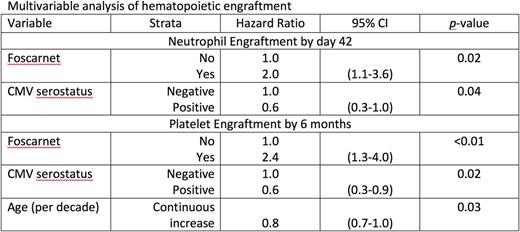Abstract
Delayed hematopoietic recovery is a major obstacle for successful use of umbilical cord blood (UCB) transplantation. In our recent report of patients receiving non-myeloablative (NMA) UCB transplantation with sirolimus/MMF as GVHD prophylaxis, we observed an association between early post-transplant HHV6 viral reactivation and delayed hematopoietic recovery. Therefore, in order to improve hematopoietic recovery, we added foscarnet (45 mg/kg twice daily) as antiviral prophylaxis for at least 10 days starting at day +7 until neutrophil engraftment. Here we report results in 19 consecutive patients treated with foscarnet and compared results in those treated with acyclovir (n=60, historical control) after NMA UCB transplant with sirolimus/MMF GVHD prophylaxis. The median age for the entire cohort was 63 years (range, 16-73 years). Acute leukemia was the principal indication for transplantation (45%). At the time of transplantation, 25% of the patients had many comorbidities (HCT-CI≥3), 21% had Karnofsky performance status (KPS) ≤80% and nearly 60% were CMV seropositive with 7 patients (9%) having had a prior allogeneic transplant (alloHCT). All patients received the same NMA conditioning regimen consisting of fludarabine (150 mg/m2), cytoxan (50mg/kg) and TBI (200 cGy) with 46% also receiving ATG if there was no recent chemotherapy. Median infused total nucleated cell dose for the entire cohort was 4.1 x107/kg (range, 2.7-9.6 x107/kg). Groups were similar except for prior alloHCT (21% vs. 5%, p=0.03) and lower KPS ≤80% (58% vs. 10%, p <0.01) in recipients of foscarnet as compared to the acyclovir cohort. Cumulative incidence of neutrophil engraftment by day 42 was 100% in the foscarnet group vs. 75% (64-85%) in those treated with acyclovir (p= 0.08). Cumulative incidence of platelet engraftment by 6 months was 95% (69-100%) for foscarnet group vs. 75% (60-90%) for acyclovir group (p=0.02). In multiple regression analysis (Table), after adjusting for CMV serostatus, neutrophil engraftment was 2-fold increased in recipients of prophylactic foscarnet as compared to acyclovir (HR=2.0, CI 95% 1.1-3.6; p= 0.02). Similarly, after adjusting for age and CMV serostatus platelet engraftment was 2.4-fold increased in recipients of foscarnet as compared to acyclovir (HR=2.4, 95% CI 1.3-4.0; p <0.01). In addition, positive recipient CMV serostatus was associated with poor hematopoietic engraftment. These data support the use of prophylactic foscarnet for prevention of HHV-6 reactivation which may delay or prevent successful engraftment after NMA UCB transplantation with sirolimus/MMF as GVHD prophylaxis.
Brunstein: Magenta Therapeutics: Research Funding; Novartis: Research Funding.
Author notes
Asterisk with author names denotes non-ASH members.


This feature is available to Subscribers Only
Sign In or Create an Account Close Modal